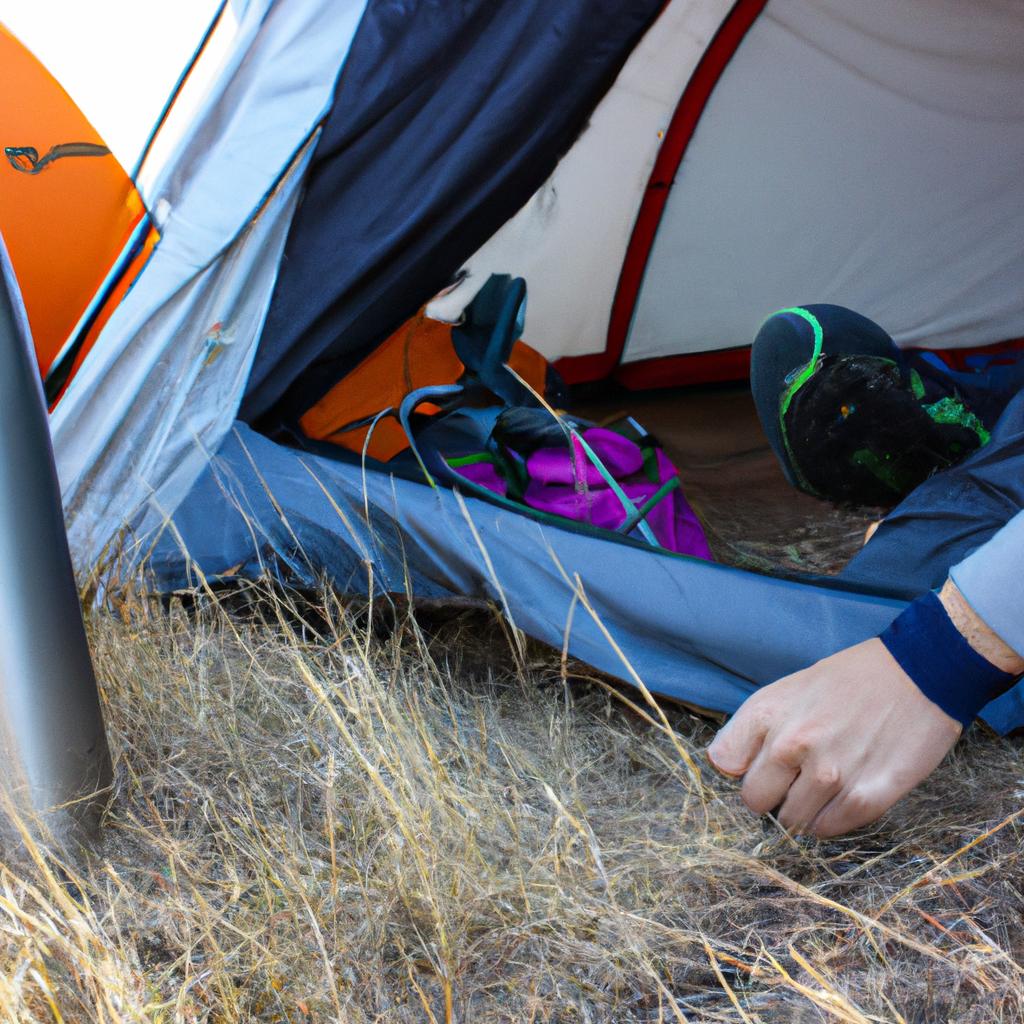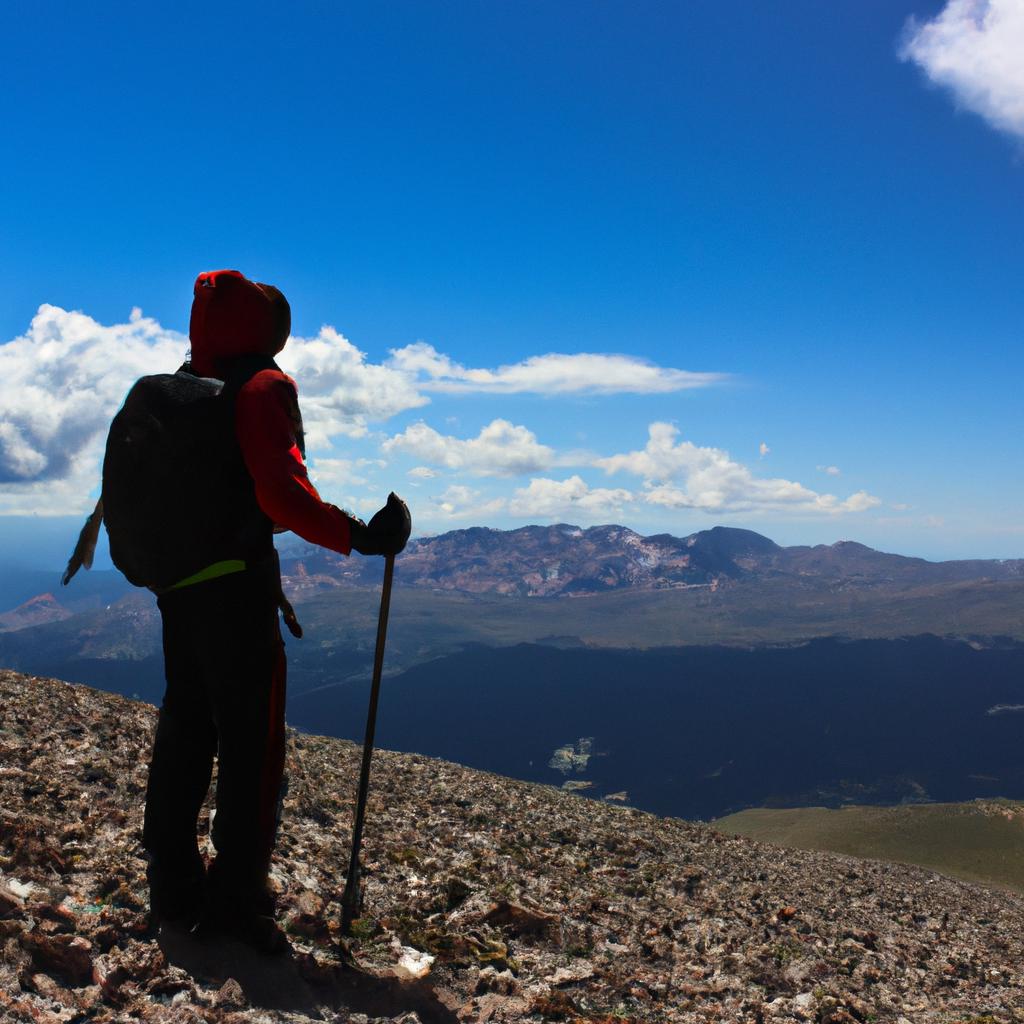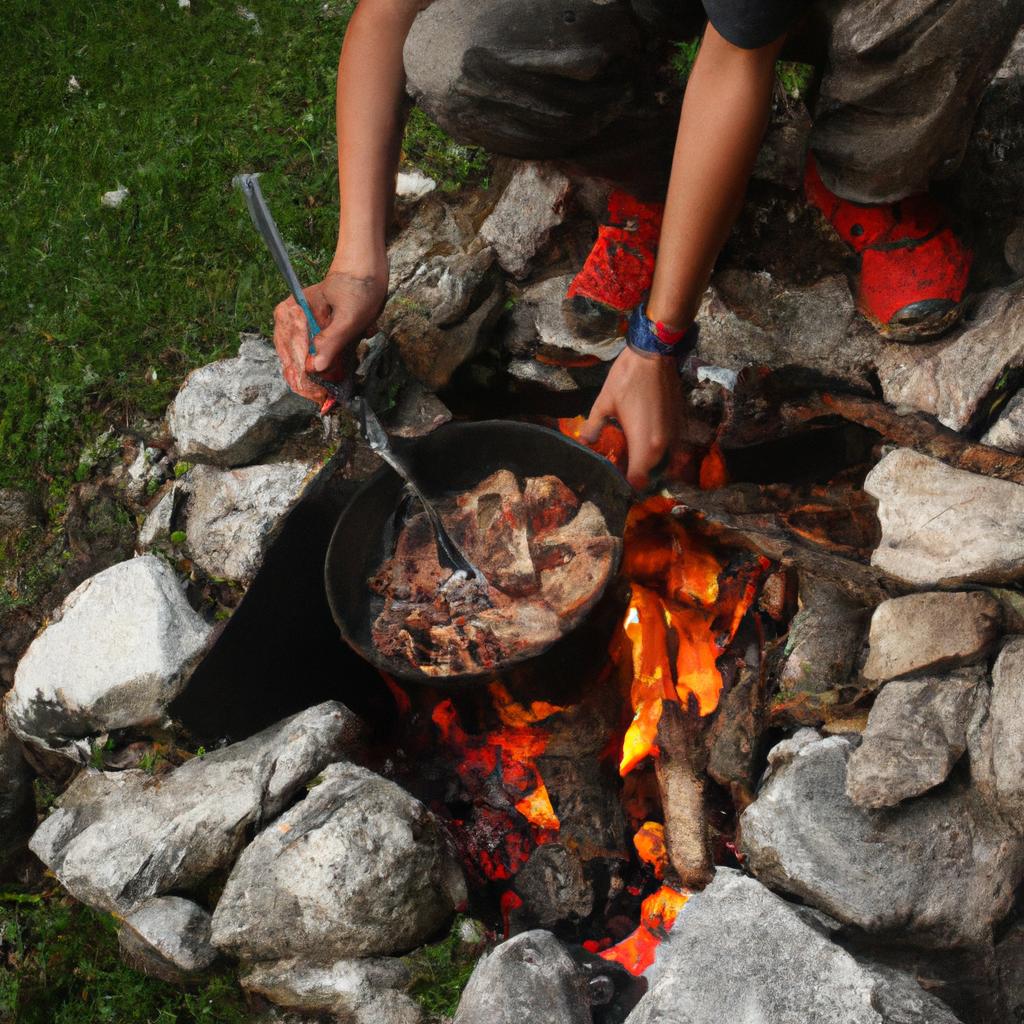Introduction
Imagine embarking on a thrilling hiking adventure deep into the heart of nature, with nothing but the sound of rustling leaves and chirping birds to accompany you. As you navigate through rugged terrains and discover hidden gems in the wilderness, having the right camping gear by your side becomes paramount. In this article, we will explore the ultimate camping gear that serves as an essential companion for all avid hikers and campers.
Consider a hypothetical scenario where Sarah, an experienced outdoor enthusiast, decides to embark on a multi-day hiking expedition in the majestic mountains. Equipped with high-quality camping gear tailored to her specific needs, she ensures her safety, comfort, and convenience during her journey. From sturdy tents that shield against harsh weather conditions to efficient cooking equipment enabling hot meals at any remote location – these essentials prove indispensable when venturing into uncharted territories.
In order to fully embrace the wonders of nature while maintaining security and comfort, it is crucial for outdoor enthusiasts to invest in reliable camping gear. This article aims to provide insights into various must-have items such as sleeping bags, backpacks, navigation tools, lighting devices, cooking utensils, and more. By understanding their importance and functionality within different outdoor settings, individuals can make informed decisions when selecting their camping gear.
Sleeping Bags:
A good quality sleeping bag is essential for a restful night’s sleep while camping. It provides insulation and keeps you warm even in chilly temperatures. Look for a sleeping bag that suits the climate and terrain of your camping destination, whether it’s a lightweight one for summer hikes or a more insulated one for winter adventures.
Backpacks:
Choosing the right backpack is key to carrying all your essentials comfortably. Look for one with adjustable straps, padded back support, and multiple compartments for organized storage. Consider the capacity you’ll need based on the length of your trip and the gear you plan to bring along.
Navigation Tools:
When exploring unfamiliar trails, navigation tools such as maps, compasses, and GPS devices are crucial. These tools help you stay on track and find your way back if needed. Familiarize yourself with their usage before setting out on your adventure.
Lighting Devices:
Having reliable lighting devices like headlamps or flashlights is vital when camping outdoors. They provide illumination during nighttime activities like setting up camp or navigating through dark paths. Opt for durable, waterproof options with long battery life.
Cooking Utensils:
Preparing hot meals in the wilderness can be both enjoyable and necessary. Invest in lightweight cooking utensils like portable stoves, cookware sets, and utensils designed specifically for outdoor cooking. Look for compact options that are easy to carry without compromising functionality.
Water Filtration Systems:
Access to clean water is essential when camping. Carrying a reliable water filtration system ensures you have access to safe drinking water throughout your journey. There are various options available such as pumps, filters, purification tablets, or gravity-fed systems.
First Aid Kits:
Accidents happen even amidst pristine landscapes. A well-stocked first aid kit should always be part of your camping gear to address minor injuries or medical emergencies promptly. Include items like bandages, antiseptic wipes, pain relievers, and any necessary personal medications.
Investing in high-quality camping gear is essential for a safe and enjoyable outdoor experience. Whether you’re embarking on a challenging hike or setting up camp near a serene lake, having the right equipment ensures your comfort, convenience, and overall well-being. By carefully selecting items like sleeping bags, backpacks, navigation tools, lighting devices, cooking utensils, water filtration systems, and first aid kits – you can confidently embrace the wonders of nature while being prepared for any adventure that comes your way.
Choosing the Right Tent for Your Camping Needs
Imagine this scenario: You and your friends embark on an adventurous hiking trip to explore the breathtaking beauty of a national park. As night falls, you find yourself surrounded by nature’s tranquility and decide to set up camp amidst towering trees and a serene river. But wait! Do you have the right tent that will provide comfort, protection, and fit your camping needs? In this section, we will delve into the key considerations when choosing a tent for your outdoor adventures.
Firstly, it is essential to assess the size requirements of your camping group. Are you traveling alone or with family and friends? A larger group may require a tent with multiple rooms or partitions for added privacy. Additionally, consider if extra storage space is needed for gear such as backpacks or cooking equipment. By determining these factors in advance, you can ensure everyone has sufficient room to sleep comfortably while keeping belongings organized.
Next, think about the weather conditions you are likely to encounter during your camping trips. If you frequently venture into areas known for heavy rainfall or strong winds, look for tents designed specifically to withstand adverse weather conditions. These tents often feature sturdy construction materials, reinforced seams, waterproof coatings, and efficient ventilation systems. On the other hand, if you primarily camp in mild climates where rain is less frequent, a lightweight and breathable tent may be more suitable.
When considering tent features, pay attention to ease of setup and portability. Look for tents that come with clear instructions and user-friendly designs like color-coded poles or quick-release buckles. This way, even novice campers can easily pitch their tents without hassle. Furthermore, if backpacking is part of your outdoor endeavors, opt for lightweight options that won’t weigh down your pack but still offer durability.
To summarize:
- Assess the size requirements of your camping group.
- Consider the expected weather conditions.
- Evaluate ease of setup and portability.
- Choose a tent that aligns with your specific needs.
By carefully considering these factors, you can select a tent that caters to your camping needs and ensures a comfortable outdoor experience. In the subsequent section, we will explore essential sleeping gear to complement your chosen tent seamlessly.
Essential Sleeping Gear for a Comfortable Outdoor Experience
Having discussed the importance of choosing the right tent for your camping needs, let us now turn our attention to another crucial aspect of a successful outdoor adventure: essential sleeping gear. To illustrate its significance, consider this hypothetical scenario: imagine you’re trekking through rugged terrain and find yourself exhausted after a long day’s hike. As night falls and temperatures drop, having proper sleeping gear becomes paramount in ensuring a comfortable and rejuvenating rest.
When it comes to equipping yourself with the necessary sleeping gear for your outdoor escapades, there are several key items that should be on your checklist:
- Sleeping Bag: A high-quality sleeping bag is an absolute must-have. Look for one that offers insulation suitable for the anticipated weather conditions during your trip.
- Sleeping Pad: This often overlooked piece of equipment provides cushioning and insulation between you and the ground, enhancing comfort while preventing heat loss.
- Pillow: While not strictly essential, bringing along a compact pillow can greatly enhance sleep quality by providing neck support and added comfort.
- Sleepwear: Investing in appropriate sleepwear designed explicitly for camping will ensure better temperature regulation throughout the night.
To give you a clear overview of their features and specifications, here is a table outlining some popular options available in today’s market:
| Brand | Model | Temperature Rating (°F) | Weight (lbs) |
|---|---|---|---|
| XYZ Outdoor Gear | Trailblazer 2000 | 20°F | 3.5 |
| ABC Adventure Co. | Summit Sleeper Pro | -10°F | 4.2 |
| DEF Camping Essentials | Alpine Hiker Ultralight | 30°F | 2.8 |
| GHI Outdoors | Trekker Extreme Down | -20°F | 4.7 |
As you can see, each option offers different temperature ratings and weights, allowing you to choose the one that best suits your specific needs. Remember to carefully consider factors such as anticipated weather conditions and personal preferences when making your selection.
Ensuring a comfortable night’s sleep in the great outdoors is essential for rejuvenation and preparing yourself for another day of adventure. With appropriate sleeping gear at hand, you’ll wake up refreshed and ready to tackle new challenges. In our next section, we will explore efficient cooking equipment for delicious campsite meals—a vital aspect of any camping experience.
Transition into the subsequent section:
With a good night’s rest secured, it’s time to turn our attention towards efficient cooking equipment for delicious campsite meals.
Efficient Cooking Equipment for Delicious Campsite Meals
Exploring Efficient Cooking Equipment for Delicious Campsite Meals
Imagine this scenario: You’re out in the wilderness, surrounded by nature’s beauty, and you’ve just finished a long day of hiking. As the sun begins to set, your stomach growls with hunger, reminding you that it’s time to prepare a warm and satisfying campsite meal. To ensure an enjoyable camping experience, having efficient cooking equipment is essential.
One example of efficient cooking gear is the portable camping stove. These stoves are compact and lightweight, making them easy to carry during your outdoor adventures. They usually run on propane or butane fuel canisters, providing a reliable heat source for cooking meals quickly and effectively.
To further enhance your campsite cooking experience, consider investing in other essential cooking equipment such as:
- Cooking Utensils: Bring along durable utensils like spatulas, tongs, and knives specifically designed for outdoor use. These tools will make food preparation easier and more convenient.
- Pots and Pans: Opt for lightweight yet sturdy pots and pans made from materials like aluminum or titanium. They distribute heat evenly while being easy to clean.
- Grill Grates: If you enjoy grilling outdoors, grill grates are a great addition to your camping gear. They allow you to cook meats and vegetables over an open flame without worrying about them falling into the fire.
- Coolers: Keeping perishable foods fresh during extended camping trips is crucial. Invest in a high-quality cooler with insulation properties that will keep your food cold for longer periods.
Now let’s take a look at how these items compare using a table:
| Cooking Equipment | Pros | Cons |
|---|---|---|
| Portable Stove | Compact; provides reliable heat | Requires additional fuel canisters |
| Cooking Utensils | Convenient; makes food prep easier | May need to be replaced over time |
| Pots and Pans | Lightweight; easy to clean | Can be expensive depending on material |
| Grill Grates | Allows for grilling outdoors | Adds extra weight to camping gear |
As you can see, each piece of cooking equipment has its own advantages and disadvantages. It’s important to consider your specific needs and preferences when choosing the right gear for your camping trips.
To ensure a safe and enjoyable cooking experience at your campsite, always follow proper safety precautions, such as keeping flammable items away from open flames and using caution when handling hot objects.
Transitioning into the subsequent section about “Must-Have Lighting Tools for Safety and Convenience,” it is essential to shed light on another crucial aspect of camping: lighting tools. These tools not only provide illumination but also enhance safety and convenience during nighttime activities in the great outdoors.
Must-Have Lighting Tools for Safety and Convenience
Let us now turn our attention to another essential aspect of a successful camping trip – lighting tools. Adequate lighting not only ensures safety in the wilderness but also provides convenience during nighttime activities.
Imagine yourself sitting around a cozy campfire after sunset, sharing stories and roasting marshmallows with your friends or family. To enhance this experience and ensure visibility in low-light conditions, it is crucial to have reliable lighting tools at hand. One example is the versatile LED headlamp, which allows you to keep your hands free while providing ample illumination for tasks such as setting up tents or preparing food.
To further illustrate the significance of proper lighting on a camping trip, consider the following key points:
- Safety: Proper lighting helps prevent accidents by illuminating potential hazards like uneven terrain or obstacles in the dark.
- Convenience: Having portable light sources readily available makes it easier to navigate through campsites and find items within backpacks or tents.
- Ambiance: Thoughtfully chosen lanterns or string lights can create a warm and inviting atmosphere, making evenings spent outdoors even more enjoyable.
- Emergency preparedness: In case of unexpected situations requiring immediate attention, having dependable flashlights or signal flare devices becomes imperative.
Now let’s delve into a three-column table highlighting some popular types of lighting tools commonly used by outdoor enthusiasts:
| Type | Description | Benefits |
|---|---|---|
| LED Headlamps | Lightweight and hands-free | Enhanced visibility; ideal for various activities |
| Lanterns | Provide 360-degree illumination | Create ambient light; suitable for group settings |
| Flashlights | Portable and versatile | Easy to carry; offers focused beam of light |
As we conclude this section on lighting tools, it is evident that they play a vital role in ensuring safety and convenience during camping trips. With the right lighting equipment, you can navigate your surroundings with ease while creating an inviting atmosphere for memorable outdoor experiences.
Transitioning into our next section on reliable navigation tools to keep you on track, let us now explore how these instruments assist campers in finding their way amidst nature’s vast playground.
Reliable Navigation Tools to Keep You on Track
Imagine yourself hiking through a dense forest, surrounded by towering trees and winding trails. As you navigate the wilderness, it becomes essential to have reliable tools that can guide you safely towards your destination. In this section, we will explore some indispensable navigation tools that will keep you on track during your outdoor adventures.
To illustrate the importance of these navigation tools, let’s consider a hypothetical scenario. Imagine you are embarking on a challenging multi-day hike in an unfamiliar mountain range. The trail is known for its rugged terrain and unpredictable weather conditions. Without proper navigation tools, finding your way could be extremely difficult and potentially dangerous.
Here are four crucial navigation tools that every hiker should have:
- Compass: A compass is a timeless tool that allows you to determine direction accurately. It uses magnetic properties aligned with Earth’s magnetic field to provide orientation even when other electronic devices fail or run out of battery.
- GPS Device: Global Positioning System (GPS) devices utilize satellite technology to pinpoint your exact location coordinates within seconds. These devices often come equipped with topographic maps, waypoints, and other useful features for precise navigation.
- Map and Map Case: Carrying a detailed map of the area you’re exploring is fundamental for effective navigation. Additionally, using a waterproof map case ensures protection against rain or accidental water exposure.
- Altimeter Watch: An altimeter watch not only tells time but also provides altitude measurements based on atmospheric pressure changes. This information helps monitor elevation gain or loss during hikes while aiding in route planning and decision-making.
| Tool | Function | Benefits |
|---|---|---|
| Compass | Determine | Provides accurate directional |
| direction | guidance regardless of | |
| electronic device reliability | ||
| GPS Device | Pinpoint | Instantly locates your exact |
| location | coordinates using satellite | |
| technology | ||
| Map and | Visualize | Provides a detailed visual |
| Map Case | route | representation of the area, |
| planning | aiding in effective navigation | |
| Altimeter | Measure | Monitors elevation gain or loss |
| Watch | altitude | for better route planning |
Having these reliable navigation tools at your disposal will not only enhance your safety but also provide peace of mind during outdoor adventures. With their assistance, you can confidently explore new trails, discover hidden gems, and enjoy the beauty of nature without worrying about getting lost.
As we have discussed the significance of reliable navigation tools, it is equally important to equip yourself with useful and compact tools for outdoor survival. Let’s delve into this topic in our next section
Useful and Compact Tools for Outdoor Survival
Explore the Ultimate Camping Gear: Your Essential Companion for Hiking and Camping!
Now, let’s dive deeper into some specific instruments that can help you stay on track during your outdoor adventures.
To illustrate the significance of these tools, imagine a scenario where you’re trekking through an unfamiliar forest. Suddenly, thick fog descends upon you, obscuring all landmarks. In this situation, having reliable navigation tools becomes essential for finding your way back to safety.
One crucial tool is a compass—a small yet mighty device that allows you to determine direction accurately. With its needle always pointing north, a compass helps you navigate unfamiliar terrains and prevents getting lost even in challenging conditions such as dense forests or featureless landscapes.
Here are four must-have navigation tools every adventurer should consider:
- GPS devices: These handheld gadgets use satellite signals to provide precise location information, making them ideal for pinpointing your whereabouts in remote areas.
- Topographic maps: Detailed topographic maps offer valuable insights about elevation changes, vegetation patterns, water sources, and other crucial features found along your route.
- Altimeters: Altimeters measure altitude based on atmospheric pressure changes. They assist in gauging ascent or descent progress and estimating remaining distance to reach desired locations.
- Trail markers and guidebooks: Physical trail markers like blazes or cairns combined with informative guidebooks help hikers follow designated paths without straying off course.
Now, let’s take a look at how these navigation tools stack up against one another:
| Tool | Pros | Cons |
|---|---|---|
| Compass | Always functional | Requires map interpretation |
| GPS Devices | Accurate positioning | Reliant on battery life |
| Topo Maps | Comprehensive | Bulky and vulnerable |
| Altimeters | Precise altitude | Limited to elevation only |
As you can see from the table above, each tool has its advantages and limitations. Combining multiple navigation tools ensures a higher level of reliability and redundancy in case one fails or is not suitable for certain situations.
While reliable navigation tools are invaluable when exploring the great outdoors, it’s important to remember that they are just part of your overall preparedness arsenal. Alongside these instruments, being well-informed about weather conditions, practicing safe hiking techniques, and having emergency communication devices should also be prioritized.
By equipping yourself with essential navigation gear like compasses, GPS devices, topographic maps, altimeters, and guidebooks, you’ll enhance your ability to navigate confidently through any terrain you encounter during your outdoor adventures. So go forth and explore without hesitation – armed with the right tools, nothing will stand between you and unforgettable experiences amidst nature’s beauty.




